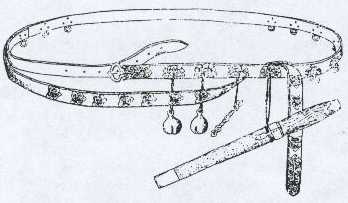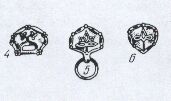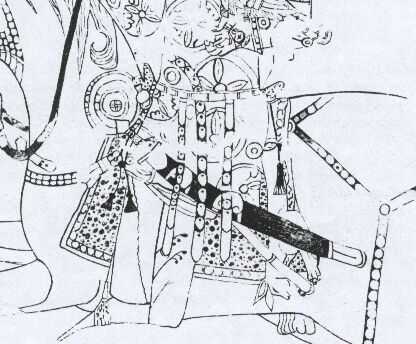
|
|
|---|
|
Last Page Update: Contact Copyright Information Main Page Structure of the Red Kaganate Gatherings, Events, . . . Historic Steppes Tribes Legends of the Nomads Flags and other Identifiers Clothing and Apearance Games and Military Arts Public Forum Resource Links
Editor: |
The design of early (Honfoglalas period) Magyar belts is something that has as far as I'm aware, only been discovered within a few cultures of Eastern Europe and the Steppes. Although similarly decorated to Persian styles of belt the method of fastening is unique in that it utilises an inner functional strap end and an outer decorative length of strap.
There are basically three types of plaques worn around the belt, they will be numbered corresponding to the numbers on the illustration: 4 - Pierced - a small rectangular hole in the lower portion of the plaque which is used to hang small implements…bells, flints, small knives(the belt would have to be pierced also);
5 - Looped - usually similar to the decorative plaque but with a small loop at the bottom for attaching a larger ring. This ring is then used as the point for attaching larger items such as bow cases, quivers, sabres etc.
N.B. The point at which the belt loops over and hangs down to the knee is where you will change the direction the plaques are placed on the belt so that the bottom of the plaques is always pointing down.
Bibliography Birka II:1, Systematische Analysen der Graberfunde, Ed. Greta Arwidsson. Chapter 16. Beutel und Taschen. Anne-Sofie Graslund. Almqvist & Wiksell International, Stockhol - Sweden 1984 Birka II:2, Systematische Analysen der Graberfunde, Ed. Greta Arwidsson. Chapter 10. Gurtel und Gurtelzubehor vom orientalischen Typ1. Ingmar Jansson. Almqvist & Wiksell International, Stockholm- Sweden. Emlekezzunk Regiekrol, Kepes Tortenelem. Editor and date published unknown.
.
|
Copyright
|
Silk Road Designs - http://www.oocities.org/normanjfin/silkroad Where Author is specified, Copyright is retained by Author with express permission for use by "The Red Kaganate" organisation. Where Author is unspecified, Copyright is retained by Norman J. Finkelshteyn. |




